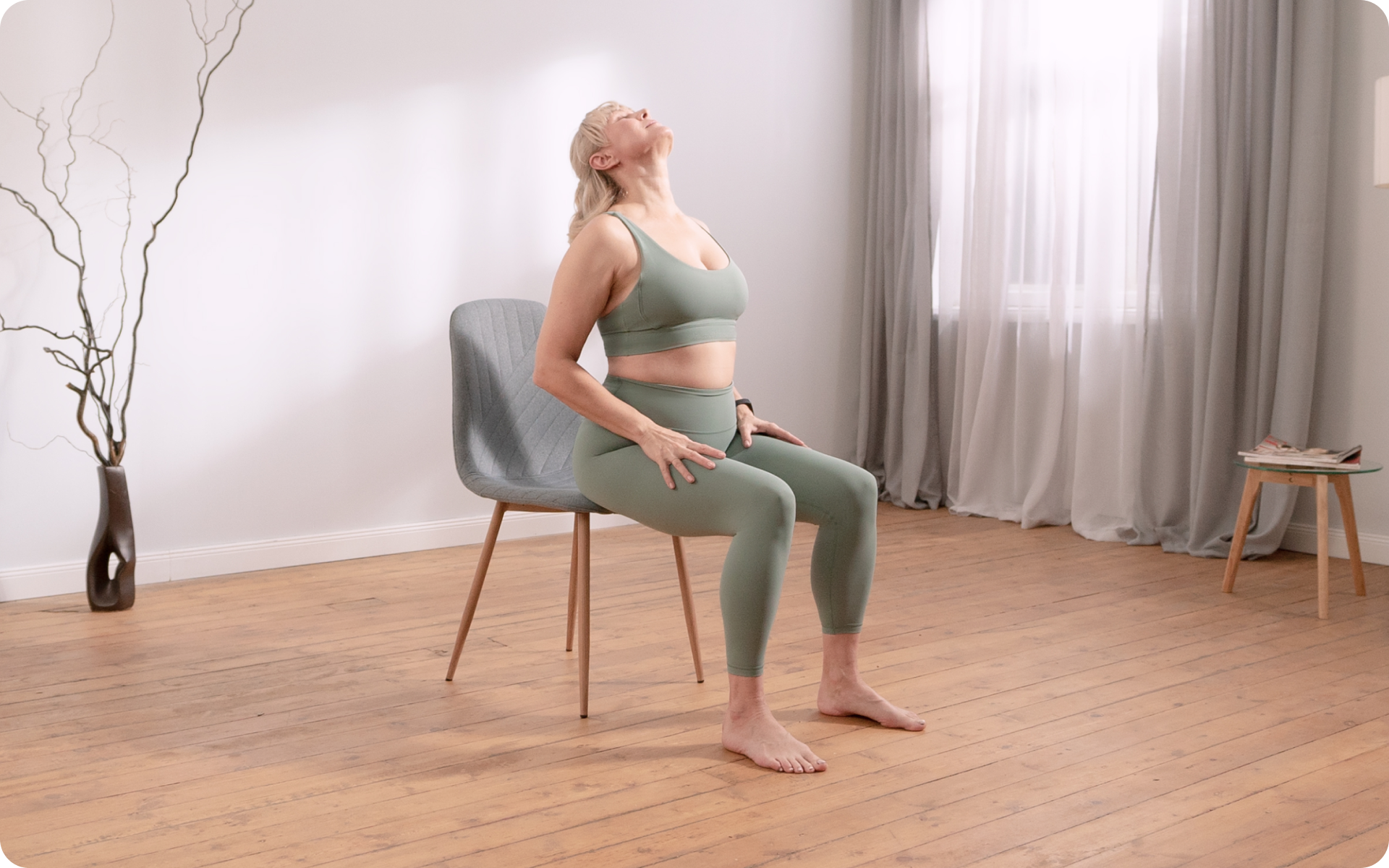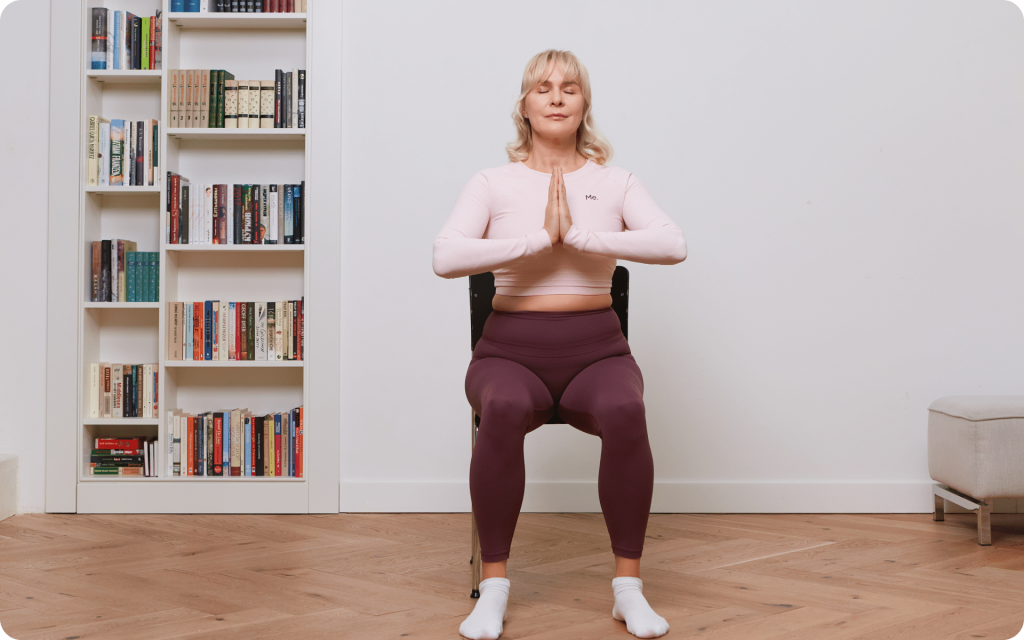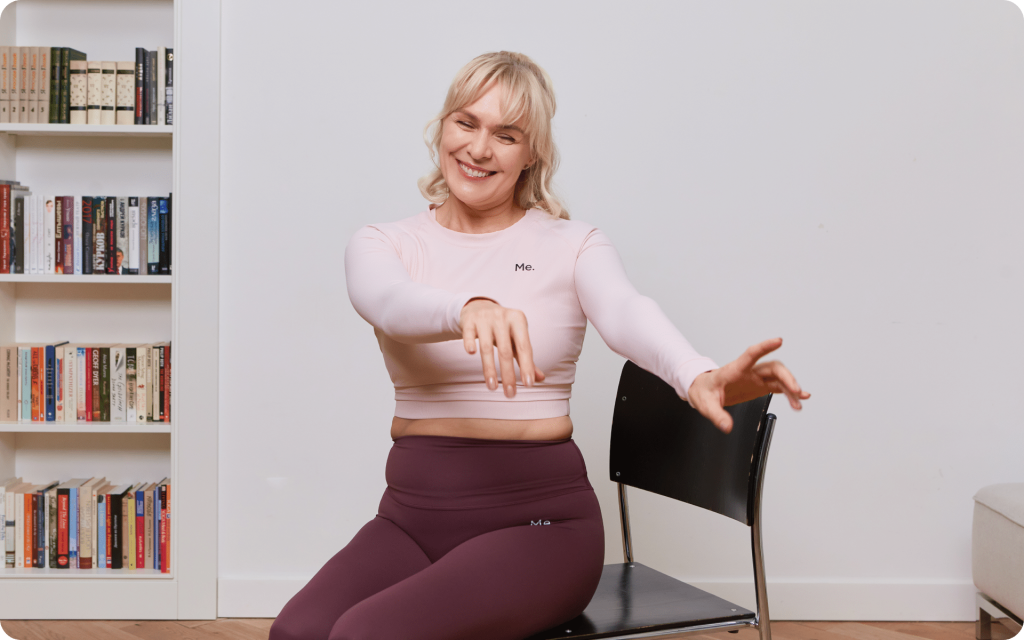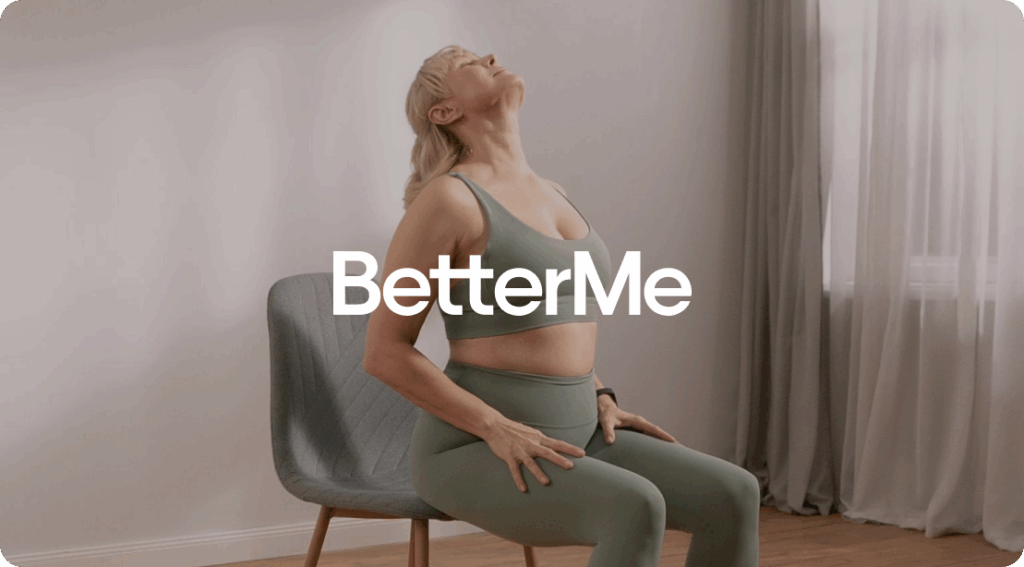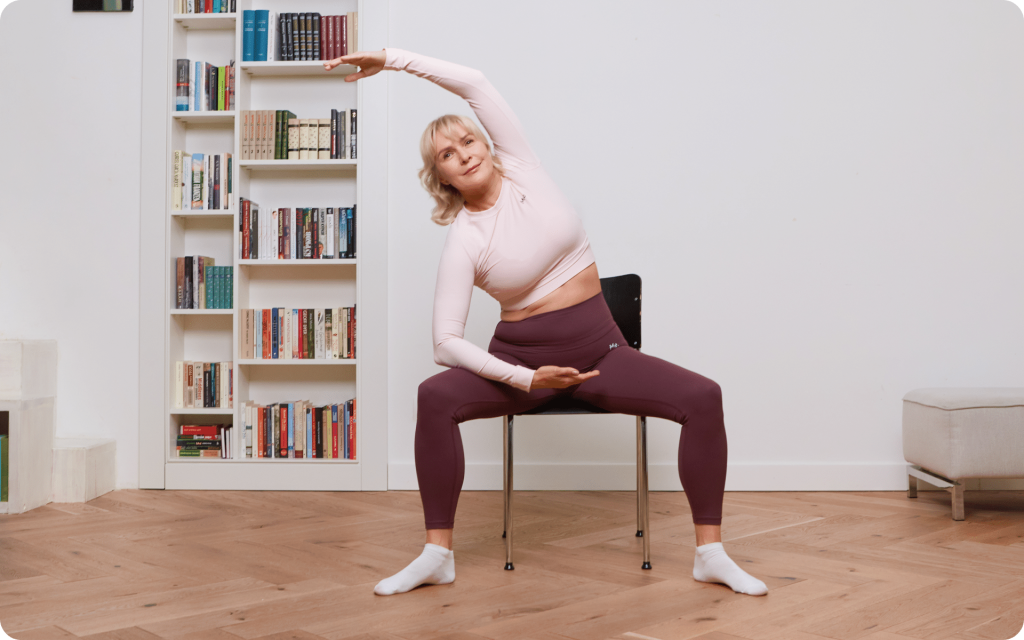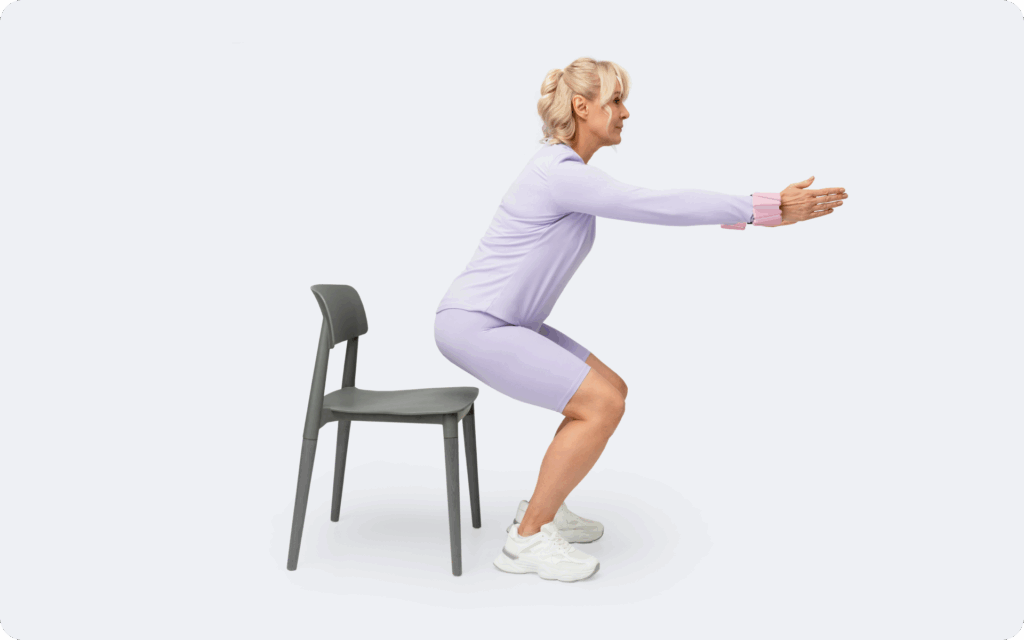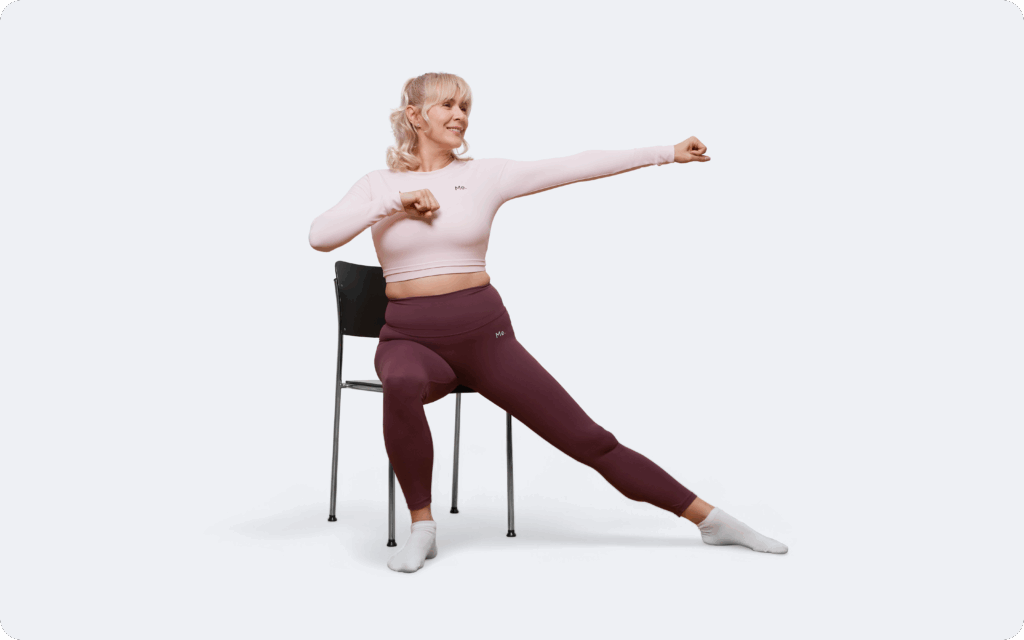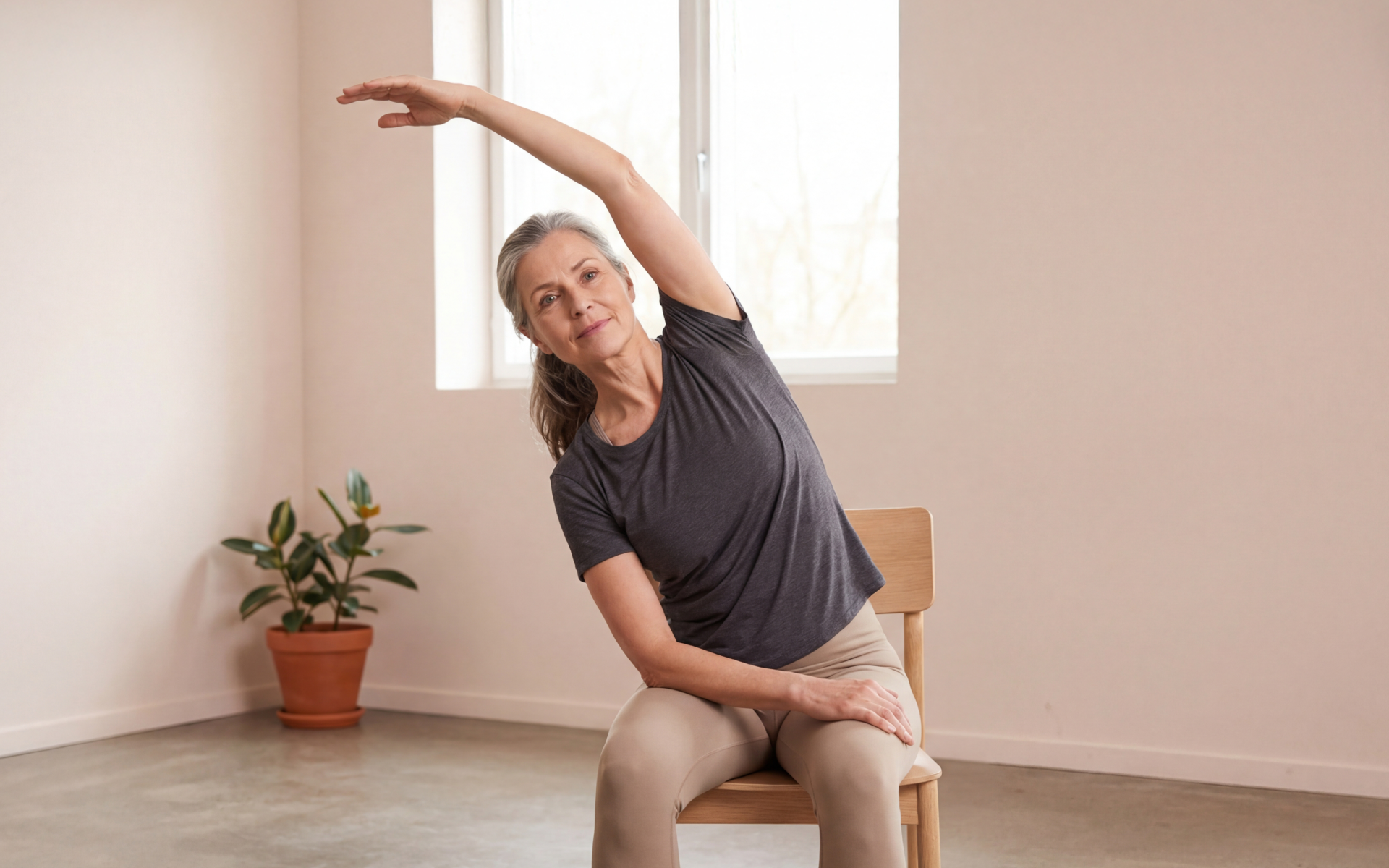As we age, maintaining mobility becomes crucial for independence and overall well-being. The beauty of chair yoga lies in its adaptability, which allows it to meet seniors where they are in their fitness journey.
Unlike standing yoga poses that may feel intimidating or unsafe, chair-supported movements provide stability while still delivering meaningful physical benefits.
In this article, we will discuss 7 senior chair yoga exercises to improve mobility.
The senior chair yoga exercises we’ll share today focus on gentle movements that target the areas seniors commonly struggle with, such as:
- Tight hips
- Stiff shoulders
- Reduced spinal mobility
Each movement incorporates principles from both physical therapy and traditional yoga, creating a bridge between rehabilitation and wellness practices.
Which Type Of Yoga Is Best For Seniors?
Many wonder, what is the gentlest chair yoga for older adults?
Seniors benefit most from yoga styles that prioritize gentle movement, proper alignment, and modifications for physical limitations (1).
The top choices that emerge for older adults include:
- Chair yoga
- Restorative yoga
- Gentle Hatha yoga
Chair yoga specifically addresses the unique needs of seniors who may have mobility restrictions, balance issues, or chronic conditions. This practice eliminates the need to get up and down from the floor. This common barrier prevents many seniors from participating in traditional yoga classes, making chair yoga a safe and feasible alternative (2).
The physical activity guidelines for seniors recommend 2 components:
- At least 150 minutes of moderate-intensity aerobic activity weekly
- At least 2 muscle-strengthening activities on 2 or more days (3).
Chair yoga can contribute to both requirements when practiced consistently with proper intensity and effort.
Balance training becomes particularly crucial for seniors, as falls represent a leading cause of injury in older adults (4).
Chair yoga incorporates subtle balance challenges while providing the security of seated support. This controlled environment improves mobility while reducing fear of falling (5).
Flexibility maintenance is another key consideration.
The “use it or lose it” principle applies strongly to joint mobility (6).
Chair yoga addresses this by regularly moving joints through their full range of motion.
This ongoing movement practice helps to maintain and improve flexibility over time (7).
Read more: 5-Minute Chair Yoga for Seniors: Science-Backed Moves to Boost Daily Activity
Does Chair Yoga Really Work For Seniors?
Scientific evidence supports the effectiveness of chair-based exercise programs for seniors (7). A study published in the Journal of the American Geriatrics Society found that participants in chair yoga programs showed significant improvements in numerous measurements, including (8):
- Overall sense of well-being
- Pain management
- Sleep quality
Here’s a quick rundown of 4 more excellent health benefits seniors can get from chair yoga.
- The biomechanical benefits are measurable as well.
Seated spinal movements can improve vertebral mobility (9), while seated arm movements maintain shoulder range of motion (10).
The key lies in consistency rather than intensity; regular practice of gentle movements yields better results than sporadic, intense sessions.
- Neurological benefits also extend beyond the physical.
Chair yoga incorporates mindful movement patterns that challenge coordination and cognitive function (11). This dual focus on physical and mental engagement aligns with current research on successful aging strategies.
- The cardiovascular benefits, while moderate, are still meaningful for seniors.
Gentle flowing movements can elevate heart rate modestly, contributing to overall cardiovascular health (12).
More importantly, chair yoga helps maintain the mind-body connection that often deteriorates with age and sedentary behavior (13).
- Research specifically examining yoga for seniors consistently shows improvements in quality of life measures.
These include reduced anxiety, better mood regulation, and increased confidence in physical abilities (14).
The social aspect of group chair yoga classes adds another layer of benefit through community engagement.
Reasons why BetterMe is a safe bet: a wide range of calorie-blasting workouts, finger-licking recipes, 24/7 support, challenges that’ll keep you on your best game, and that just scratches the surface! Start using our app and watch the magic happen.
Can You Lose Weight With Chair Yoga For Seniors?
Chair yoga can contribute to weight management for seniors, though it’s not primarily a weight-loss exercise.
Understanding the role it plays requires examining both caloric expenditure and metabolic factors specific to aging.
The direct caloric burn from chair yoga is modest, typically 50-80 calories per 30-minute session for most seniors (15).
However, weight management in older adults involves more complex factors than simply calorie counting (16):
- Muscle mass preservation
- Metabolic rate maintenance
- Improved insulin sensitivity
Chair yoga supports weight management indirectly through several mechanisms.
The stress-reduction benefits can help regulate cortisol levels (19), which influence fat storage patterns, particularly around the midsection (20).
- Sleep quality improvements from regular chair yoga practice can indirectly support healthy weight management (21). Poor sleep disrupts hormones that regulate hunger and satiety, making weight control more challenging for seniors (22).
- The most significant contribution chair yoga makes to weight management is adherence. Seniors are more likely to stick with an exercise routine they find enjoyable and manageable. Consistency trumps intensity for long-term weight management success.
For seniors specifically focused on weight loss, chair yoga is most effective with a comprehensive approach that includes appropriate nutritional modifications and additional forms of physical activity, as tolerated.
What Are Some Low-Impact Senior Chair Yoga Exercises?
These seven exercises target the areas where seniors commonly experience stiffness and mobility limitations.
- Seated Cat-Cow Stretch
This exercise focuses on spinal mobility.
The movement alternates between flexing and extending the spine while strengthening the deep spinal muscles that support posture.
The biomechanics focus on segmental spinal movement, where each vertebra should move independently rather than the spine moving as a single rigid unit.
This segmentation helps maintain the natural curves of the spine and prevents compensation patterns.
Steps to perform:
- Sit up straight in your chair with feet flat on the floor.
- Place your hands on your knees or thighs.
- Slowly arch your back, lifting your chest and looking slightly upward (cow position)
- Hold for 2-3 seconds, taking deep breaths.
- Slowly round your spine, tucking your chin toward your chest (cat position)
- Hold for 2-3 seconds, feeling the stretch between your shoulder blades.
- Repeat 8-10 times, moving slowly and smoothly
- Seated Side Body Stretch
This lateral flexion movement targets the intercostal muscles and quadratus lumborum, areas that become particularly tight from prolonged sitting.
The stretch helps maintain lateral spinal mobility and can alleviate lower back stiffness.
The key biomechanical principle involves pure lateral flexion without rotation or forward flexion.
Many people compensate by leaning forward when attempting side bends, which reduces the effectiveness of the stretch.
Steps to perform:
- Sit upright with both feet planted firmly on the ground
- Place your right hand on the seat beside your hip for support.
- Raise your left arm overhead, reaching toward the ceiling.
- Slowly lean to the right, creating a gentle arc with your left arm.
- Keep your left hip grounded in the chair seat.
- Hold for 15-20 seconds, breathing normally.
- Slowly return to the center and repeat on the opposite side.
- Perform 3-4 repetitions on each side.
- Seated Spinal Twist
Rotational movements become increasingly vital as we age because daily activities often lack sufficient spinal rotation. This exercise helps maintain the health of spinal discs and surrounding muscles while improving overall trunk mobility.
The biomechanical focus centers on rotating from the thoracic spine rather than forcing movement from the lumbar region. The lumbar spine has limited rotational capacity; therefore, movement should originate from the mid-back area.
Steps to perform:
- Sit tall with your back away from the chair back
- Cross your arms over your chest, with your hands touching opposite shoulders.
- Engage your core muscles gently.
- Slowly turn your upper body to the right, keeping your hips facing forward.
- Turn only as far as comfortable without forcing the movement.
- Hold for 10-15 seconds while breathing normally.
- Slowly return to the center and repeat to the left.
- Complete 5-6 repetitions in each direction
- Seated Forward Fold
This exercise addresses tight hamstrings and promotes spinal flexion mobility.
The forward fold also provides a gentle inversion effect that can aid in improving circulation and stress reduction.
The biomechanical principle involves hinging at the hips rather than simply rounding the spine. This distinction protects the lower back while effectively stretching the posterior chain muscles.
Steps to perform:
- Sit toward the front edge of your chair
- Place feet hip-width apart, flat on the floor.
- Sit up tall, lengthening through the crown of your head.
- Slowly hinge forward at your hips, keeping your back straight initially.
- Allow your arms to hang naturally or rest your hands on your legs.
- Only fold as far as comfortable, and you should feel a gentle stretch in your hamstrings.
- Hold for 20-30 seconds, taking deep breaths.
- Slowly roll up one vertebra at a time to return to sitting.
- Seated Eagle Arms
This upper body exercise targets shoulder mobility and helps counteract the internal rotation posture typical in seniors. The movement stretches the posterior deltoids and rhomboids while strengthening the muscles that support good posture.
The biomechanical focus involves creating space between the shoulder blades while maintaining neutral spine alignment. The wrapping action of the arms creates a unique stretch pattern that’s difficult to achieve with other exercises.
Steps to perform:
- Sit tall with feet planted firmly on the ground
- Extend both arms straight out to your sides at shoulder height.
- Cross your right arm over your left at the elbow joint.
- Bend both elbows and try to bring your palms together (or as close as possible)
- Lift your elbows slightly while keeping your shoulders relaxed.
- Hold for 15-20 seconds, feeling the stretch between your shoulder blades.
- Release and shake out your arms.
- Repeat with left arm crossing over right.
- Seated Ankle Circles
Lower extremity circulation becomes increasingly crucial for seniors, and ankle mobility has a direct impact on walking mechanics and balance.
This simple exercise promotes circulation while maintaining the health of your ankle joints.
The biomechanical principle focuses on isolated ankle movement without compensatory movement from the knee or hip. A full range of motion in all directions helps maintain the flexibility needed for safe ambulation.
Steps to perform:
- Sit comfortably with your back supported
- Lift your right foot slightly off the ground.
- Point your toe and slowly draw large circles with your foot.
- Complete 8-10 circles in one direction
- Reverse direction for another 8-10 circles
- Focus on moving only your ankle, keeping your leg still.
- Lower your foot and repeat with the left ankle.
- Perform 2-3 sets on each side.
- Seated Mountain Pose with Arms
This exercise combines postural awareness with gentle arm movements to improve circulation and body awareness.
It serves as both an active exercise and a mindfulness practice.
The biomechanical emphasis lies in active postural engagement rather than passive sitting. This posture engagement teaches mature adults how to support their spine using their own muscle strength rather than relying entirely on external support.
Steps to perform:
- Sit toward the front edge of your chair
- Place feet flat on the floor, hip-width apart
- Lengthen through the crown of your head, creating space between your ears and shoulders.
- Rest your arms at your sides with palms facing forward.
- Take a deep breath and slowly raise your arms above your head.
- Keep your shoulders relaxed as you reach your arms toward the ceiling.
- Hold for 5-10 seconds while breathing normally
- Slowly lower your arms back to your sides
- Repeat 6-8 times, coordinating movement with breath
Learn more about seated chair yoga poses to expand your practice with additional modifications and variations.
Read more: Seated Yoga for Seniors: 8 Gentle Exercises to Restore Mind and Body
What Are Squats In Chair Yoga For Seniors?
Chair-assisted squats represent one of the most functional exercises seniors can perform. They directly translate to the sit-to-stand movement required for daily activities while building the leg strength essential for independence.
The biomechanical analysis of chair squats reveals their importance for seniors.
The movement pattern mirrors getting up from chairs, toilets, and car seats, activities that become increasingly challenging with age. Regular practice of this movement can maintain and improve functional capacity (23).
The chair serves as both a safety mechanism and a progression tool.
- Senior chair yoga exercises for beginners can utilize the chair for full support.
- Stronger individuals can progress to barely touching the seat before standing.
This scalability makes the exercise appropriate for a wide range of fitness levels.
BetterMe: Health Coaching app helps you achieve your body goals with ease and efficiency by helping to choose proper meal plans and effective workouts. Start using our app and you will see good results in a short time.
Muscle activation during chair squats includes the following muscle groups:
- Glutes
- Quadriceps
- Core stabilizers.
These muscle groups work together to control the descent and power the ascent, making it a compound movement that delivers significant functional benefit (24).
Regression options include using armrests for additional support or reducing the range of motion by placing a cushion on the chair seat.
Progression involves removing hand support, adding pauses at the bottom position, or eventually progressing to standing squats.
Steps to perform chair squats:
- Stand in front of your chair with feet hip-width apart
- Keep your feet planted firmly on the ground throughout the movement
- Slowly lower yourself toward the chair seat, pushing your hips back first
- Lightly touch the chair seat without fully sitting down
- Immediately push through your heels to return to standing
- Keep your chest up and knees tracking over your toes
- Use your arms for balance but avoid pushing off your thighs
- Start with 5-8 repetitions and gradually increase as strength improves
The progression timeline varies among seniors, but most can advance from using the chair for full support to performing modified squats within 4-6 weeks of consistent practice.
Discover the full range of chair pose yoga benefits and how this fundamental movement can transform daily function for seniors.
How Many Times A Week Should A Senior Do Chair Yoga?
The physical activity guidelines from the Centers for Disease Control and Prevention recommend that seniors engage in muscle-strengthening activities at least 2 days per week (25). Chair yoga can fulfill part of this recommendation while also contributing to flexibility and balance training.
For optimal benefits, seniors should aim for chair yoga sessions 3-4 times per week, with each session lasting 20-30 minutes.
This frequency allows for adequate recovery between sessions while maintaining the consistency needed for improvement.
The principle of progressive overload also applies to gentle exercises like chair yoga.
Progressive overload is the fundamental training principle that says in order to continue progressing, you must consistently place a greater demand on the muscles incrementally over time.
Seniors can progress by gradually increasing several training variables, including:
- Session duration
- Adding more repetitions
- Incorporating slight variations to familiar movements
- Adding to the total load (such as senior chair yoga exercises with weights)
Recovery considerations become more important with age.
Seniors may need 48 hours between more challenging sessions, but can perform gentle daily movements. The low-impact nature of chair yoga makes it suitable for frequent practice. Individual factors influence optimal frequency.
Seniors with chronic conditions may benefit from shorter, more frequent sessions.
Those new to exercise might start with 2 chair yoga sessions per week and gradually increase frequency as their bodies adapt.
The weekly chair yoga session schedule might look like:
- Monday (20 minutes)
- Wednesday (25 minutes)
- Friday (20 minutes)
- Optional gentle stretching on other days.
This pattern provides consistency while allowing for adequate recovery.
Balancing chair yoga with other activities is important.
Seniors should also aim for cardiovascular exercise and resistance training when possible (24). Chair yoga complements these activities by enhancing flexibility and fostering a mind-body connection.
Explore a comprehensive chair yoga routine for seniors to create a balanced weekly practice schedule.
Both yoga and walking provide unique benefits for seniors, making them complementary rather than competing activities. The ideal senior fitness program incorporates both activities. Chair yoga becomes particularly valuable for seniors who have mobility limitations that make walking challenging, while walking serves as excellent cardiovascular exercise for those who can tolerate it. Chair yoga contributes to weight management but isn’t primarily a weight-loss exercise. For seniors focused on weight loss, combining chair yoga with other forms of exercise and a balanced diet yields better results. Vinyasa-style chair yoga, which links movement with breath, can provide an energy expenditure of about 143 calories over 50 minutes, meeting the criteria for moderate-intensity physical activity (28). However, the greatest weight-loss benefit comes from chair yoga’s role in building sustainable exercise habits and reducing stress-related eating patterns (29). The chair-assisted squat ranks as the most functional exercise for seniors because it directly relates to daily activities like rising from chairs, toilets, and cars. This movement pattern maintains leg strength, which is essential for independence, while being scalable for different fitness levels (30). The functional carryover to real-world activities makes it more valuable than exercises that don’t translate to daily movements. Chair squats can be performed safely by most seniors and provide measurable improvements in functional capacity. For seniors, morning chair yoga sessions often work best because energy levels are typically highest earlier in the day. Morning practice can improve circulation, reduce morning stiffness, and set a positive tone for the day. However, individual schedules and energy patterns should guide timing decisions. Some seniors find gentle evening chair yoga helps with relaxation and sleep quality. The most important factor is consistency, choose a time that allows for regular practice rather than worrying about “the best time.”Frequently Asked Questions
Is yoga or walking better for seniors?
What is the best yoga for seniors to lose weight?
What is the number one exercise for seniors?
Is it better to do yoga in the morning or at night?
The Bottom Line
Chair yoga offers seniors a practical path to maintaining mobility, strength, and well-being without the barriers that traditional yoga might present. The 7 exercises we outlined here provide a foundation for daily movement that can adapt to changing needs and abilities over time.
Starting with just 10-15 minutes of daily practice can yield meaningful benefits within weeks. The key lies in consistency rather than perfection, showing up regularly matters more than executing every movement flawlessly.
Remember that progression in chair yoga might look different than in traditional fitness programs. Improvements might include feeling steadier when standing, experiencing less morning stiffness, or simply feeling more confident in your body’s abilities.
DISCLAIMER:
This article is intended for general informational purposes only and does not serve to address individual circumstances. It is not a substitute for professional advice or help and should not be relied on for making any kind of decision-making. Any action taken as a direct or indirect result of the information in this article is entirely at your own risk and is your sole responsibility.
BetterMe, its content staff, and its medical advisors accept no responsibility for inaccuracies, errors, misstatements, inconsistencies, or omissions and specifically disclaim any liability, loss or risk, personal, professional or otherwise, which may be incurred as a consequence, directly or indirectly, of the use and/or application of any content.
You should always seek the advice of your physician or other qualified health provider with any questions you may have regarding a medical condition or your specific situation. Never disregard professional medical advice or delay seeking it because of BetterMe content. If you suspect or think you may have a medical emergency, call your doctor.
SOURCES:
- Yoga for Healthy Aging: Science or Hype? (2021, pmc.ncbi.nlm.nih.gov)
- The Effectiveness of Chair Yoga in Older Adults: A Literature Review (2023, researchgate.net)
- What Counts as Physical Activity for Older Adults (2023, cdc.gov)
- The Effect of Balance and Coordination Exercises on Quality of Life in Older Adults: A Mini-Review (2019, frontiersin.org)
- Safety and feasibility of modified chair-yoga on functional outcome among elderly at risk for falls (2012, pmc.ncbi.nlm.nih.gov)
- Age-related mobility loss is joint-specific: an analysis from 6,000 Flexitest results (2013, link.springer.com)
- The Effect of Chair-Based Exercise on Physical Function in Older Adults: A Systematic Review and Meta-Analysis (2021, mdpi.com)
- A Pilot Randomized Controlled Trial of the Effects of Chair Yoga on Pain and Physical Function Among Community-Dwelling Older Adults With Lower Extremity Osteoarthritis (2017, pubmed.ncbi.nlm.nih.gov)
- Immediate effects of dynamic sitting exercise on the lower back mobility of sedentary young adults (2015, pmc.ncbi.nlm.nih.gov)
- Natural and forced arm reach ranges in sitting position (2021, sciencedirect.com)
- MAINTAINING BRAIN HEALTH VIA TELEHEALTH-BASED CHAIR YOGA FOR RURAL UNDERSERVED OLDER ADULTS (2023, academic.oup.com)
- Intensity of Hatha yoga training for older adults (2025, nature.com)
- ONLINE CHAIR YOGA VIABLE FOR ISOLATED OLDER ADULTS WITH DEMENTIA (2022, fau.edu)
- Chair Yoga and Why Seated Yoga Poses Are Good For You (2023, brownhealth.org)
- Energy Costs of Chair Sitting and Standing Video Exercises in Chinese Older Adults Over 60 Years (2023, pubmed.ncbi.nlm.nih.gov)
- Weight Loss Strategies in the Elderly: A Clinical Conundrum (2019, pmc.ncbi.nlm.nih.gov)
- Exercise and metabolic health: beyond skeletal muscle (2021, pmc.ncbi.nlm.nih.gov)
- Metabolic changes in aging humans: current evidence and therapeutic strategies (2022, pmc.ncbi.nlm.nih.gov)
- Impact of a stress management program on weight loss, mental health and lifestyle in adults with obesity: a randomized controlled trial (2018, pmc.ncbi.nlm.nih.gov)
- Chronic stress increases vulnerability to diet-related abdominal fat, oxidative stress, and metabolic risk (2014, pubmed.ncbi.nlm.nih.gov)
- A PILOT STUDY OF GENTLE YOGA FOR SLEEP DISTURBANCE IN WOMEN WITH OSTEOARTHRITIS (2012, pmc.ncbi.nlm.nih.gov)
- Sleep Deprivation: Effects on Weight Loss and Weight Loss Maintenance (2022, mdpi.com)
- Movement velocity in the chair squat is associated with measures of functional capacity and cognition in elderly people at low risk of fall (2018, pmc.ncbi.nlm.nih.gov)
- Squatting Exercises in Older Adults: Kinematic and Kinetic Comparisons (2012, pmc.ncbi.nlm.nih.gov)
- Older Adult Activity: An Overview (2023, cdc.gov)
- 12 Benefits of Walking (n.d., arthritis.org)
- Exploring the therapeutic effects of yoga and its ability to increase quality of life (2011, pmc.ncbi.nlm.nih.gov)
- Energy Expenditure in Vinyasa Yoga Versus Walking (2017, pubmed.ncbi.nlm.nih.gov)
- Yoga’s potential for promoting healthy eating and physical activity behaviors among young adults: a mixed-methods study (2018, ijbnpa.biomedcentral.com)
- Movement velocity in the chair squat is associated with measures of functional capacity and cognition in elderly people at low risk of fall (2018, pmc.ncbi.nlm.nih.gov)
